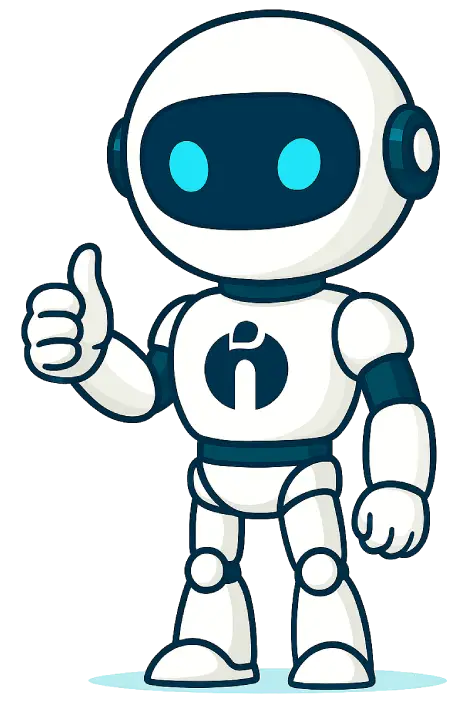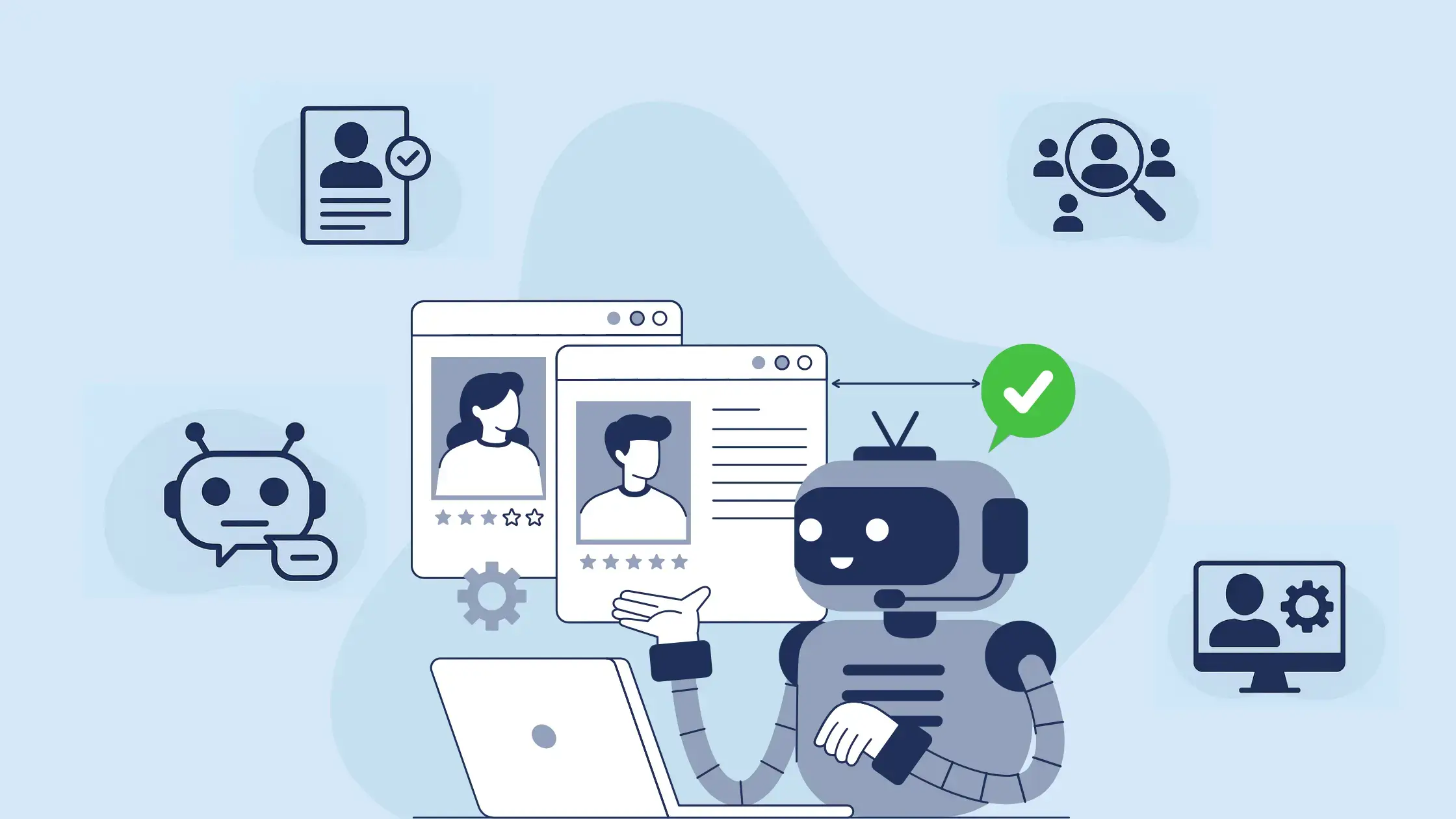Are your sourcing strategies missing out on a world of diverse talent and fresh ideas? Imagine you're cooking dinner, but you're only using salt—bland, right? Now, think of adding a dash of pepper, a pinch of paprika, and a sprinkle of herbs. That's what Diversity and Inclusion in Sourcing can do for your business.
When you open up your sourcing to include a variety of voices and experiences, you're not just checking a box. You're bringing in new perspectives that can spark innovation and challenge the status quo. But it's not just about diversity; it's about inclusion too. It's about creating a workspace where everyone feels valued and heard, where every idea has a chance to shine.
So, are you ready to turn your monotone sourcing strategy into a symphony of diverse talents? Let's dive in and explore how to truly embrace Diversity and Inclusion in Sourcing and make your business rock!
What is Diversity and Inclusion in Sourcing?
Diversity and Inclusion (D&I) in sourcing involves actively seeking and engaging talent from all walks of life, not just to fill quotas but to enrich your workforce with varied perspectives and experiences. Diversity includes things like race, gender, age, and disabilities, while inclusion makes sure these diverse candidates feel respected from the time they are hired until they advance in their careers.
It's not just about doing the right thing; it's also a smart business move. Embracing D&I not only makes the hiring process fairer but also builds a team that mirrors the diverse global market, enhancing creativity, innovation, and overall business performance.

Why Diversity and Inclusion in Sourcing Matters?
Incorporating diversity and inclusion (D&I) in sourcing is crucial for creating stronger, more innovative teams. Diverse talent provides unique viewpoints, which helps to solve problems creatively and adapt to changes effectively—similar to having a variety of specialised tools in your toolkit.
Here’s why it matters:
- Better Business Outcomes: Companies with diverse teams consistently outperform in profitability and productivity thanks to fresh approaches and ideas.
- Broader Talent Pool: D&I expands your talent pool, uncovering skilled professionals from underrepresented groups who might otherwise be overlooked.
- Improved Retention: Inclusive workplaces foster belonging, boosting employee satisfaction and reducing turnover.
- Stronger Employer Brand: Candidates, especially younger ones, prefer organisations that champion diversity and inclusion.
D&I in sourcing isn’t about ticking boxes—it’s about unlocking talent and opportunities for growth while setting your business up for long-term success.
Strategies to Incorporate D&I in Sourcing
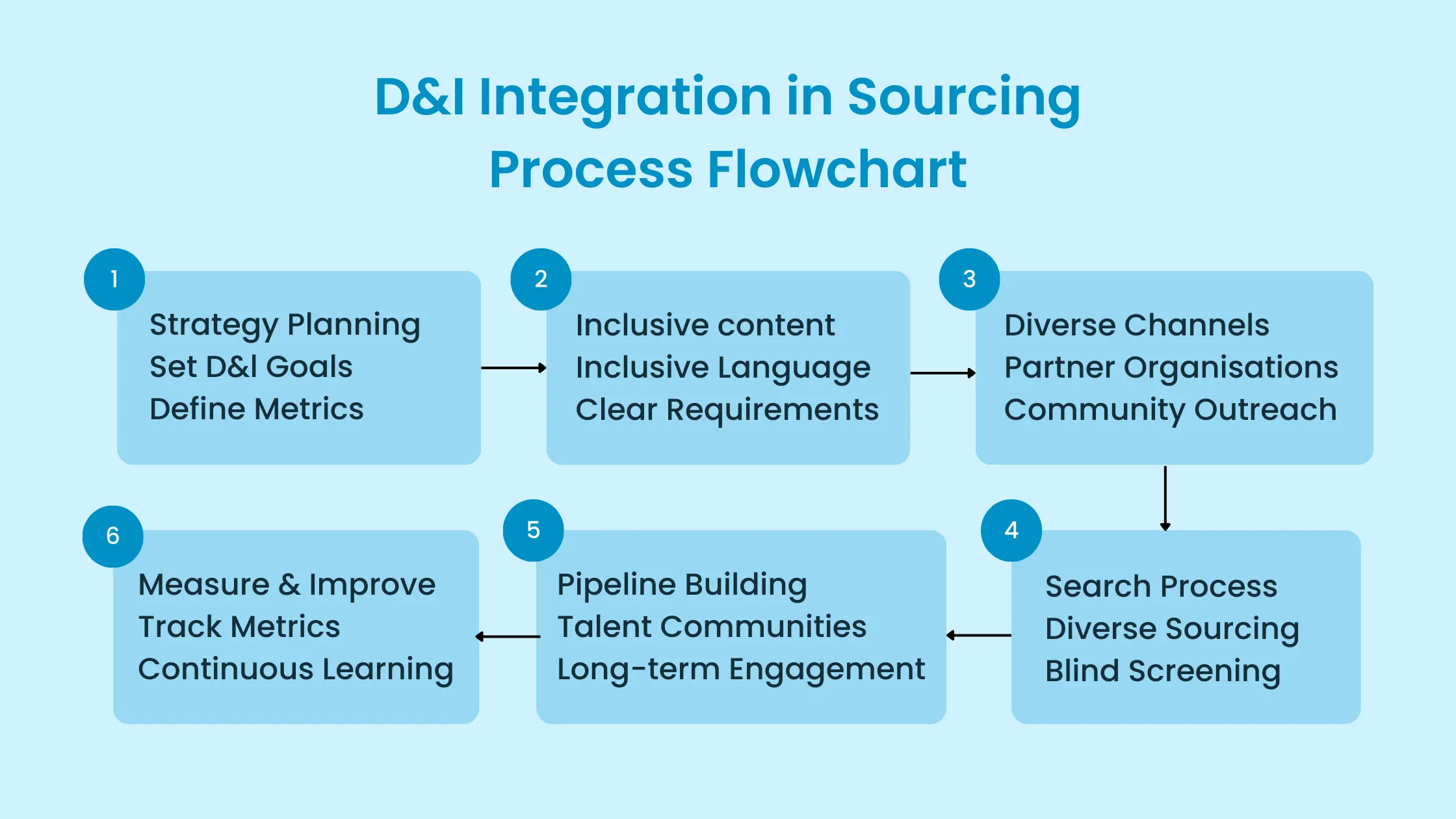
1. Strategic Foundation: Building a Strong Base
To integrate diversity and inclusion in sourcing, start by understanding its value. Diversity offers new viewpoints, and inclusion makes sure all opinions are respected. This approach is not only morally right but also boosts creativity and business growth.
Set measurable goals, like increasing representation in your talent pool, and track progress using sourcing metrics such as diversity ratios. Create an inclusive plan by looking beyond typical job sites, collaborating with diverse groups, and using inclusive language in job postings.
Leadership support is crucial. Make sure your diversity and inclusion (D&I) goals match your business objectives and get their commitment to provide resources and promote cultural change. To ensure accountability, assign someone responsible for these goals and regularly check on progress. A solid foundation will help ensure your D&I efforts are successful and long-lasting.
2. Sourcing Channel Diversification
Diversifying your sourcing channels ensures you’re reaching a broad range of talented individuals. Here’s how to do it effectively:
- Diverse Professional Networks: Tap into groups like Women Who Code or Black Professionals Network to connect with underrepresented talent pools already thriving in professional communities.
- Specialised Job Boards: Posting job openings on platforms specifically designed for diverse hiring is a game-changer. Websites like DiversityJobs, WeAreLatinx, or AbilityJobs cater to groups that may not frequent mainstream job boards. These platforms help you reach talent that aligns with your D&I goals.
- Educational Institutions: Engage with Historically Black Colleges and Universities (HBCUs), Hispanic-Serving Institutions (HSIs), and other schools with diverse student bodies. Hosting internships, sponsoring scholarships, or attending their career fairs helps you create a talent pipeline directly from these institutions.
- Employee Resource Groups (ERGs): Partner with your ERGs to tap into their networks. They can help refer candidates from underrepresented backgrounds and provide valuable insights into creating an inclusive candidate experience.
By diversifying your sourcing channels, you’re not just broadening your reach but creating meaningful opportunities and fostering an inclusive workplace.
3. Job Description and Communication
Crafting inclusive job descriptions is key to attracting diverse talent. Use language that is friendly and neutral, and avoid words like "ninja" or "rockstar" which could make some people feel unwelcome. Instead, use tools like Textio to help make your descriptions more inclusive.
Remove biased terminology; for example, say "strong communication skills" instead of "native English speaker," and stay away from phrases that suggest a strict work environment. Focus on the most important qualifications to make sure the job requirements are fair and don't discourage potential candidates.
Highlight your company’s commitment to diversity by mentioning initiatives, programs, or awards that showcase your dedication to inclusion, such as active mentorship programs for underrepresented groups.
Clearly mention that you are ready to help all candidates, letting them know how they can ask for any changes they need. This openness not only broadens your talent pool but also reinforces your commitment to an inclusive hiring process.
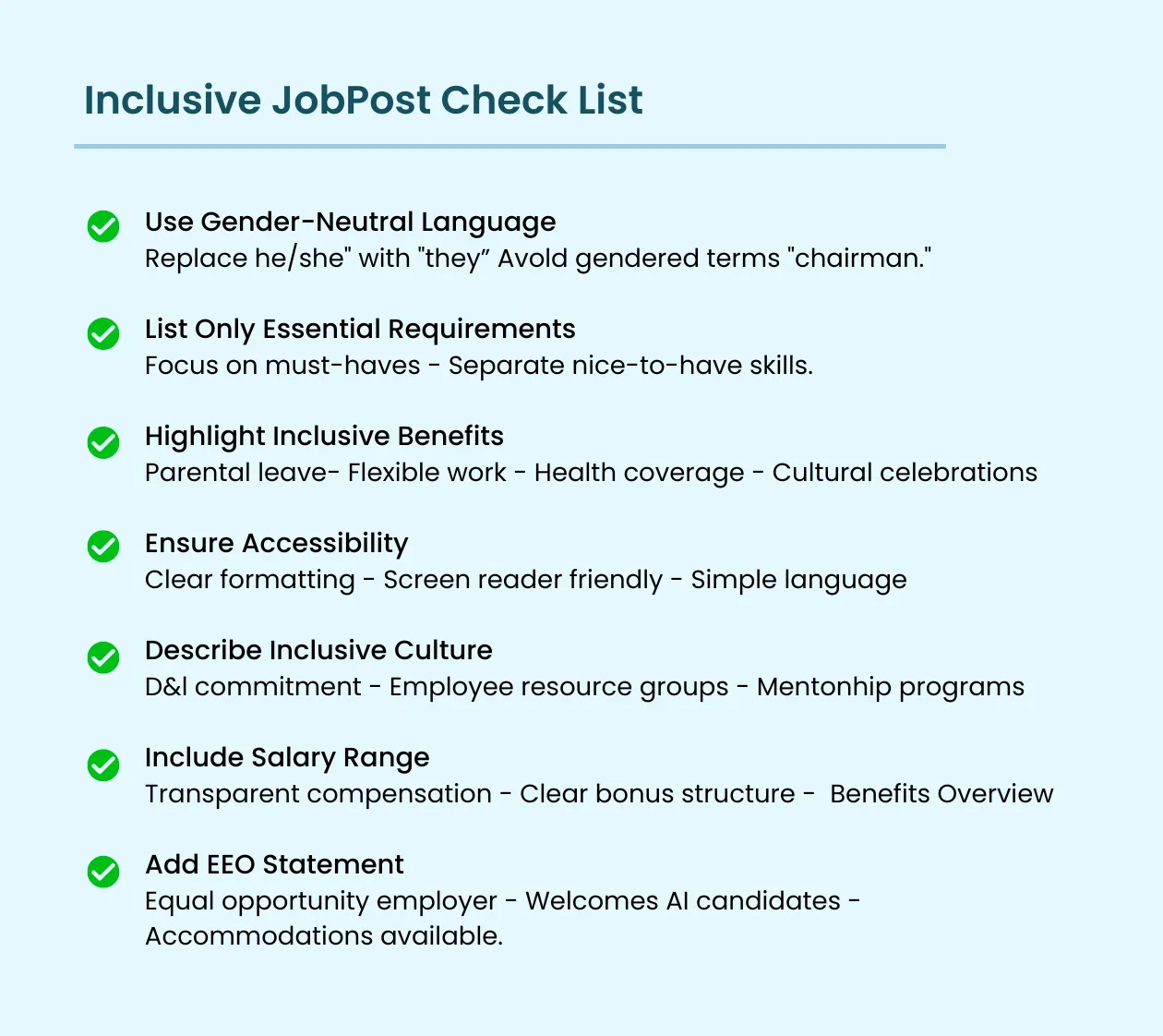
4. Search Process Optimisation: Building Fairness
Optimising the search process ensures fairness and promotes diversity at every step. Here’s how:
1. Implement Blind Screening: Remove identifying details like names or addresses from resumes to focus solely on skills and experience. Use tools to automate this process for consistency.
2. Create Diverse Sourcing Panels: Include individuals from varied backgrounds in your sourcing team to broaden outreach strategies and reduce bias.
3. Set Diversity Targets: Aim for balanced representation in candidate pools, such as a percentage of underrepresented groups, to actively expand talent searches.
4. Standardise Evaluation Criteria: Use a clear rubric to assess candidates based on skills and competencies, ensuring decisions are objective and consistent.
These steps help build an inclusive sourcing process, opening doors to stronger, more diverse talent.
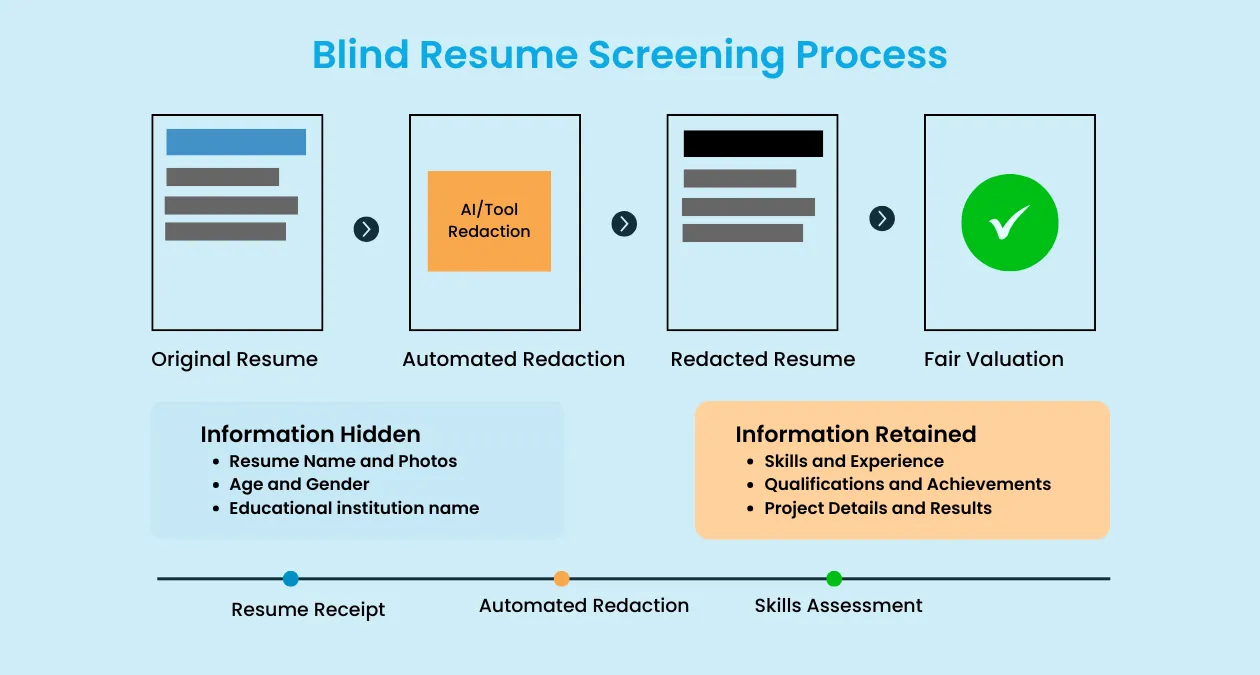
5. Technology and Tools
Using AI tools in sourcing can make processes smoother, but we need to be cautious to prevent them from making old biases worse. By regularly checking and updating AI algorithms, we can ensure they focus on skills and experience instead of potentially biased factors like demographics. Platforms such as Jopwell and DiversifyTech are essential for connecting with underrepresented talent pools, expanding reach, and ensuring inclusivity from the outset.
Using data analytics tools like Tableau or Power BI is important for showing diversity numbers and finding areas where your sourcing strategy needs improvement so you can make specific changes. Inclusive CRM systems, like iSmartRecruit, help keep communication with all candidates fair and professional, ensuring everyone feels included.
Moreover, tools like Textio that automatically check for biased language help ensure all communication is inclusive.
By carefully using these tools, you not only improve the speed of your sourcing process but also promote diversity and inclusion in your recruitment efforts.
6. Team Development
Developing your team is critical to embedding diversity and inclusion in sourcing. Start by training sourcers to notice and stop hidden biases that can affect choices, like judging someone based on their name or background. Using clear ways to judge people can help make things fair.
Equip your team with cultural competency to understand diverse communication styles and values. This helps ensure that reaching out and judging people is fair and respectful. Building a diverse sourcing team with different backgrounds brings in new ideas and helps avoid mistakes in decision-making.
Establish clear sourcing guidelines, like neutral job descriptions and blind resume screening, to create a consistent and inclusive process. Lastly, keep your team informed with regular D&I training to stay up-to-date with changing practices and keep a strong focus on being inclusive.
7. Pipeline Development
Building a diverse talent pipeline is essential for sustainable hiring. Here’s how:
- Build Long-Term Diverse Talent Pools: Proactively connect with underrepresented groups through events, professional associations, and tailored databases. Maintain and nurture these connections over time.
- Create Diversity-Focused Talent Communities: Establish platforms like LinkedIn groups or forums where diverse professionals can engage with your company, fostering trust and connection.
- Develop Early Career Programs: Partner with schools and universities to offer internships, apprenticeships, and scholarships, building a future-ready, diverse workforce.
- Design Inclusive Internship Pathways: Offer meaningful internships for underrepresented groups with mentorship and clear career progression, paving the way for long-term employment.
Small, consistent efforts today will create a strong, inclusive workforce tomorrow.

8. Engagement Strategies
Engaging with diverse talent requires genuine connections and meaningful actions. Start by crafting authentic diversity messaging and sharing specific efforts like mentorship programs or collaborations to gain trust. Use blogs or videos to tell real stories of your employees, emphasising their successes to motivate potential candidates.
Ensure an inclusive candidate experience by simplifying applications, offering accommodations, and being flexible during interviews. Attract diverse talent by attending events or job fairs focused on minorities, and adjust your approach to match their goals.
Finally, create lasting community ties through scholarships, workshops, or volunteer programs, demonstrating your dedication to inclusion beyond just hiring. These actions make candidates feel appreciated and show your organisation as a place where they can succeed.
9. Measurement and Analytics
Incorporating diversity and inclusion (D&I) in sourcing requires solid data to identify what's working. Here's how to stay on track:
1. Track Diversity Sourcing Metrics: Monitor how many candidates from underrepresented groups enter your sourcing pipeline. If diversity is low, reassess your sourcing channels and outreach strategies.
2. Analyse Pipeline Diversity: Check diversity at every stage of the pipeline. If it drops midway, review your screening or assessment processes for bias.
3. Measure Conversion Rates by Demographics: Assess how well diverse candidates progress through the funnel. For example:
-
How many are shortlisted?
-
How many reach the offer stage?
-
Identify any drop-off points and their causes.
4. Assess Sourcing Channel Effectiveness: Evaluate which platforms bring in the most diverse candidates. Double down on effective channels like community partnerships or diversity job boards.
5. Conduct Regular Diversity Audits: Periodically review your sourcing processes for inclusivity. Check job ads, outreach methods, and tools for bias. Ensure hiring teams are trained to support D&I goals.
10. Continuous Improvement
Continuous improvement ensures your D&I strategy remains effective and relevant. Regularly review your sourcing process to identify biases or gaps, using metrics like applicant diversity to guide adjustments. Get opinions from diverse candidates to uncover barriers and refine practices. Use data to fix issues like candidate drop-offs and update strategies like sourcing channels or interview methods accordingly.
Tell your team and others about successful practices, such as blind resume reviews and foster collective progress. Also, keep up with evolving trends, such as remote work and shifting demographics, to adapt your approach and maintain a competitive edge.
11. Partnerships and External Relations
Forming strong partnerships with diverse organisations and joining events to focus on underrepresented groups can significantly enhance your sourcing efforts. Collaborate with associations like women in tech or veterans’ groups to access special talent pools. Use diversity-focused media by posting job openings on niche job boards and platforms. Support initiatives such as coding boot camps or leadership training for underrepresented groups to show genuine commitment to inclusion.
Also, setting up mentorship programs through these partnerships helps develop skills and build trust within diverse communities. Genuine involvement in these activities creates meaningful connections and a sustainable pipeline for diverse talent.
Final Thoughts On Diversity and Inclusion in Sourcing
Incorporating diversity and inclusion in your sourcing process is both the right thing to do and a smart business move. By actively looking for and supporting suppliers from diverse backgrounds, you encourage creativity and strength and better represent the world around you. This method helps your business financially, improves company culture, and boosts your brand's image.
To achieve inclusive sourcing, you need consistent effort, specific goals, clear communication, and a workplace where everyone feels respected. This journey involves continuous learning, adjusting, and involvement. With dedication and a commitment to inclusivity, you can build a strong, adaptable supply chain that truly reflects diverse communities, ultimately helping your business succeed.
For more insights on sourcing strategies and how to track sourcing metrics, visit our Candidate Sourcing Guide.

